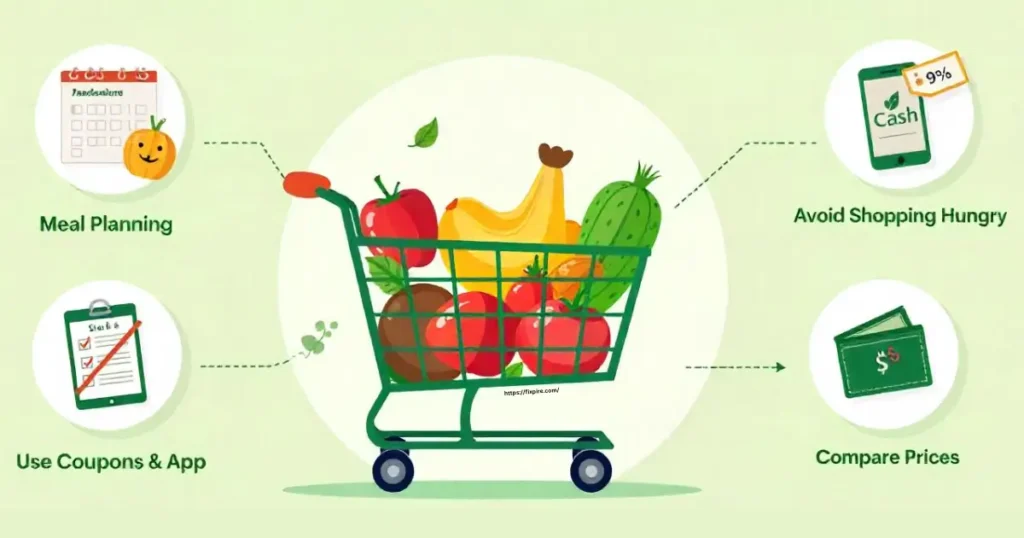Grocery shopping can take a significant chunk out of a family’s budget, especially when feeding a household of four. With rising food costs, it is essential to find ways to cut expenses without sacrificing nutrition or quality. This guide will show you how to save money on groceries for a family of 4 with smart planning while ensuring your family eats well. From meal planning to strategic shopping, these expert tips will help you stretch your grocery budget further.

How to Save Money on Groceries for a Family of 4 with Planning
Saving money on groceries for a family of four requires a mix of strategic shopping, smart meal planning, and budget-conscious decisions. By making intentional choices, you can cut down on expenses without compromising on nutrition or variety. Whether you are looking to reduce impulse purchases, buy in bulk, or make the most of seasonal produce, these expert tips will help you optimize your grocery budget. With the right approach, feeding your family on a budget can be both achievable and enjoyable.
Why Grocery Budgeting is Essential for Families
Many families struggle to keep their grocery bills under control, often overspending without realizing it. Grocery prices fluctuate based on inflation, supply chain issues, and food trends, making it even more important to manage spending effectively. A well-planned grocery budget ensures financial stability, reduces waste, and helps you make healthier choices.
✅ Benefits of Grocery Budgeting
- Helps prevent unnecessary debt accumulation
- Encourages mindful spending and meal planning
- Reduces impulse buys and overspending
- Ensures food security for your family
Now, let’s explore practical steps to save money on groceries without sacrificing quality or nutrition.
Set a Realistic Grocery Budget for a Family of Four
If you want to start saving money on groceries, the first step is to create a realistic budget. Many people shop without knowing how much they are actually spending each month, which makes it difficult to manage expenses or spot areas for improvement. So, before making any major changes, take a close look at your current grocery spending habits.
Begin by gathering your grocery receipts from the last few months or reviewing your bank statements. Add up the total you spend each month on food, including trips to the grocery store, quick convenience purchases, and takeout from supermarkets. Once you have a clear picture of your average monthly grocery costs, you can begin to plan a more intentional budget.
The average grocery budget for a family of four can vary depending on where you live, how often you cook at home, and your family’s specific dietary needs or preferences. However, a reasonable range for many families is between $600 and $1,000 per month. This provides enough flexibility to accommodate different eating habits while still encouraging mindful spending.
Once you have set a realistic target budget for your family, the next step is to track your expenses regularly to ensure you’re staying within your limit. It’s not enough to set a budget and forget about it—monitoring your spending habits over time is key to success. If you find that you are going over budget, you can start identifying what’s driving the extra costs and make adjustments accordingly.
Practical Tips to Stick to Your Grocery Budget

Even with a budget in place, sticking to it can be a challenge—especially with fluctuating food prices and busy family schedules. Here are some smart and simple strategies to help you stay on track and make the most of every dollar:
1. Use a Grocery Tracking App
Digital tools like YNAB (You Need A Budget) or Mint can make it easier to track your grocery spending in real-time. These apps categorize your purchases and offer visual breakdowns of your expenses, helping you identify patterns and find opportunities to save. You can also set budget alerts to avoid overspending throughout the month.
2. Pay with Cash
It may sound old-school, but paying with cash can be a powerful way to control your grocery spending. After setting your monthly budget, withdraw the total amount in cash and use only that for grocery purchases. This forces you to stay within your limit and prevents overspending caused by using credit or debit cards. Once the cash runs out, it’s a clear signal to stop shopping or get creative with what you already have at home.
3. Compare Monthly Spending
Make it a habit to review your grocery spending at the end of each month. Look for areas where costs have increased or unnecessary items that may have slipped into your cart. Maybe you spent extra on snacks or bought more prepared meals than usual. Recognizing these trends can help you cut back or make smarter decisions next time you shop.
4. Adjust When Necessary
Things don’t always go as planned—and that’s perfectly fine. Some months might include special occasions, holidays, or unexpected visitors that lead to higher grocery bills. Be flexible and give yourself room to adjust when needed. The key is not to be too rigid, but rather to stay aware and intentional with your spending.
Plan Meals in Advance to Avoid Overspending
Meal planning on a budget is one of the most effective ways to save money. By planning your meals for the week, you avoid unnecessary purchases and food waste.
✅ How to Meal Plan Effectively
- Check your pantry – Use what you have before buying new items.
- Plan meals around sales – Base meals on weekly store discounts.
- Create a meal schedule – Outline breakfast, lunch, and dinner for the week.
- Batch cook meals – Prepare large portions to use throughout the week.
- Choose simple, budget-friendly recipes – Stick to affordable, nutritious meals.
✅ Example Budget-Friendly Meal Plan:
- Monday: Rice and beans with roasted vegetables
- Tuesday: Spaghetti with homemade tomato sauce
- Wednesday: Chicken stir-fry with frozen veggies and rice
- Thursday: Lentil soup with whole wheat bread
- Friday: Homemade pizza with store-bought dough
- Saturday: Omelets with leftover veggies and toast
- Sunday: Slow cooker chili with beans and ground turkey
Shop with a List and Stick to It
Impulse purchases can quickly derail your grocery budget. A shopping list keeps you focused and prevents unnecessary spending.
✅ How to Create a Smart Grocery List
- Categorize by section – Organize your list by produce, dairy, proteins, etc.
- Include only necessary items – Stick to planned meals and essentials.
- Use digital lists – Apps like AnyList or Google Keep can help.
- Set a spending limit – Assign an estimated price to each item to stay on budget.
Buy in Bulk to Maximize Family Grocery Savings
Buying non-perishable staples in bulk reduces costs per unit and minimizes frequent trips to the store.
✅ Best Items to Buy in Bulk
- Rice, pasta, and grains
- Canned goods (beans, tomatoes, tuna)
- Frozen vegetables and meats
- Household essentials (toilet paper, detergent)
Warehouse stores like Costco or Sam’s Club offer great bulk deals, but always compare unit prices to ensure savings. Stock up on items your family regularly consumes to maximize savings.
Choose Generic Brands Over Name Brands

Many generic brands offer the same quality as name brands but at a lower price. Test different products and stick with the ones that meet your standards.
✅ Are Generic Brands as Good as Name Brands?
- Yes! Many store brands are manufactured by the same companies as brand-name products.
- The main difference is packaging and marketing.
- Generic brands can be 20-40% cheaper than name brands.
Use Coupons and Cashback Apps
Leverage discounts and cashback programs to save even more.
✅ Best Coupon and Cashback Apps
- Ibotta – Earn cashback on groceries.
- Rakuten – Get cashback on online grocery purchases.
- Fetch Rewards – Scan receipts to earn points for gift cards.
- Flipp – Find digital coupons for grocery stores.
Shop Seasonally and Locally
Seasonal produce is cheaper and fresher than out-of-season items. Farmers’ markets often have lower prices than grocery stores for locally grown fruits and vegetables.
✅ Seasonal Shopping Tips
- Buy berries in summer when they are cheapest.
- Stock up on root vegetables in winter.
- Visit farmers’ markets an hour before closing for discounts.
Limit Convenience Foods and Takeout
Pre-packaged meals and fast food add up quickly. Cooking from scratch is more cost-effective and healthier.
✅ How to Reduce Takeout Costs
- Cook large batches and freeze leftovers.
- Use a slow cooker for easy, homemade meals.
- Try meal prep Sundays to save time during the week.
Reduce Food Waste to Save More
Food waste equals wasted money. Store food properly, freeze leftovers, and use scraps creatively to get the most out of your groceries.
✅ Ways to Cut Food Waste
Keep track of expiration dates.
Freeze fruits and vegetables before they go bad.
Repurpose leftovers into new meals (e.g., leftover chicken for tacos).
Final Thoughts on Saving Money on Groceries
Sometimes, no matter how well we plan, life throws us a curveball—and that’s perfectly okay. Unexpected events like family gatherings, holidays, or even a sudden craving can shift your grocery needs and budget. Rather than stressing over every penny, give yourself the grace to adjust when necessary. Flexibility is part of realistic budgeting. The goal isn’t perfection—it’s progress. So, if one month goes over, learn from it and move forward with a fresh plan. You have got this! Remember, it’s not about doing it flawlessly—it’s about staying consistent. Start where you are, and keep making small steps toward smarter spending.











